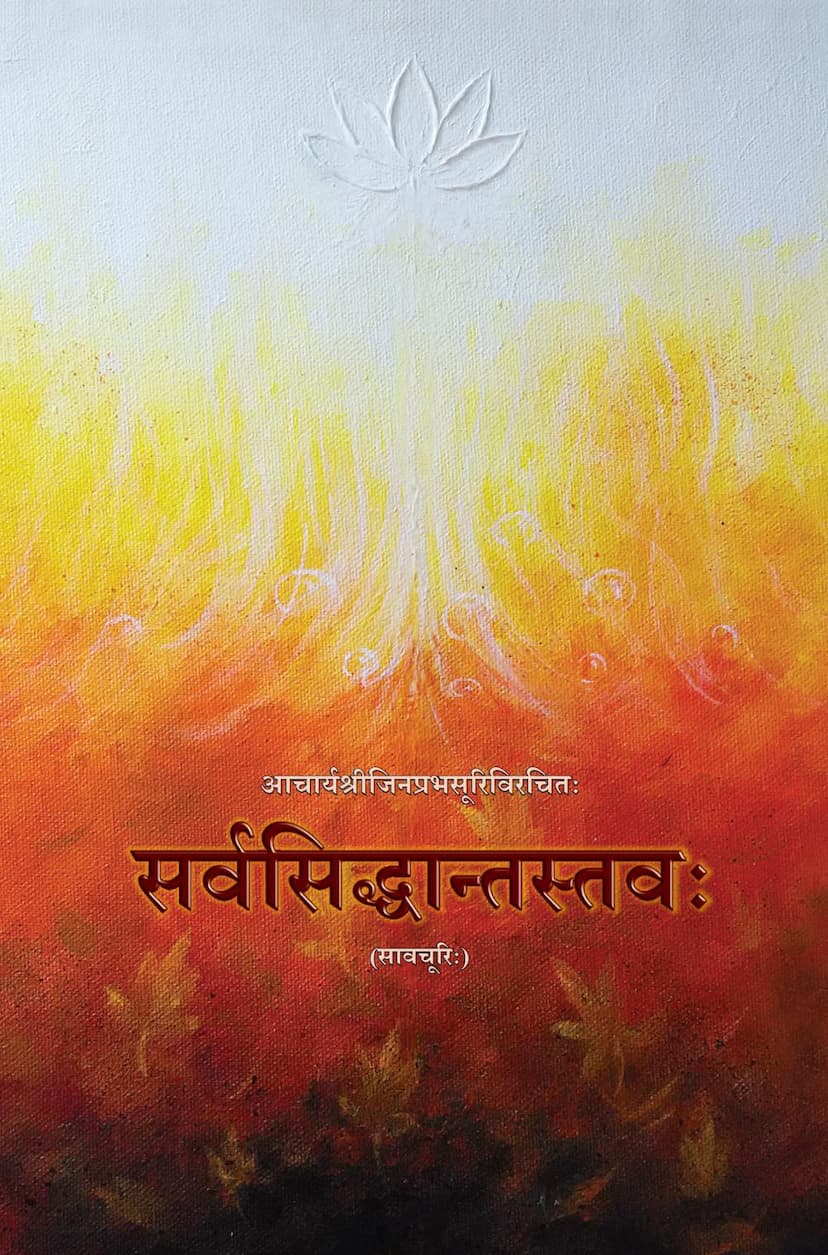Sarva Siddhanta Stava
Added to library: September 2, 2025

Summary
Summary of Sarva Siddhanta Stava
Book Title: Sarva Siddhanta Stava (सर्वसिद्धान्तस्तवः) Author: Acharya Jinaprabhasuri (आचार्यश्रीजिनप्रभसूरि) Commentary Author: Pandit Somodayagani (पं. सोमोदयगणी) Publisher: Shrutbhuvan Sansodhan Kendra (श्रुतभवन संशोधन केन्द्र) Catalog Link: https://jainqq.org/explore/009264/1
Introduction and Context:
The Sarva Siddhanta Stava is a venerated Jain text that praises the forty-five Āgamas (sacred scriptures) of the Śvetāmbara tradition. It was composed by the esteemed scholar and influential Ācārya (spiritual leader) of the Kharataragaccha, Jinaprabhasuri. The work is presented with a detailed commentary (Avacūri) by Pandit Somodayagani, making the profound meanings of the original verses accessible. The publication by Shrutbhuvan Sansodhan Kendra highlights their dedication to preserving and disseminating Jain scriptures, with this being their first publication, a tribute to the Āgamas.
Author and Historical Background:
Ācārya Jinaprabhasuri, a significant figure in Jainism, was known for his prolific literary output, believed to have composed around seven hundred stotras. A unique anecdote highlights his strict vow to compose a new stotra daily before accepting his meal. He also had a close connection with the goddess Padmāvatī. It is mentioned that he gifted his seven hundred stotras to Ācārya Somatilakasuri, a disciple of Somaprabhasuri (author of Karpurastav), based on a divine intimation about the future prominence of the Tapagaccha. This act of selfless dedication underscores Jinaprabhasuri's commitment to the propagation of Jain knowledge.
Ācārya Somatilakasuri, the recipient of these stotras, was a disciple of Somaprabhasuri and a prominent figure in the Tapagaccha. His life dates are recorded as being born in VS 1355, initiated in VS 1369, and achieving the position of Sūri in VS 1372. He passed away in VS 1424.
Content and Structure:
The Sarva Siddhanta Stava itself is a collection of forty-six verses that laud the forty-five Āgamas of Jainism. The verses are composed in various meters like Anuṣṭup, Āryā, and Upajāti. The stotra systematically praises each of the Āgamas, providing a brief overview of their subject matter.
The commentary by Pandit Somodayagani meticulously analyzes each verse, breaking down the meaning of words and phrases, and offering insights into the significance and miraculous qualities of the Āgamas mentioned. The commentary also sheds light on the historical context and the author's intentions.
Praise of the Āgamas:
The stotra follows a specific order in praising the Āgamas, which differs slightly from the commonly accepted enumeration. The order presented is:
- Four Mūlasūtras: Āvaśyaka Sūtra, Daśavaikālika Sūtra, Ogha Niryukti, and Piṇḍa Niryukti.
- Nandi and Anuayogadvāra: These are described as introductory texts and the pathway to understanding the Āgamas.
- Ṛṣibhāṣita: While sometimes considered part of Prakīrṇaka, it is given independent mention.
- Eleven Aṅgas: Ācārāṅga, Sūtra kṛtāṅga, Sthānāṅga, Samavāyāṅga, Bhagavātī (Vipāka Sūtra), Jñātādharmakathā, Upāsakadaśā, Antakṛddaśā, Anuṭṭharopapātika daśā, Praśnavyākaraṇa daśā, and Vipāka Sūtra.
- Twelve Upāṅgas: Opapātika, Rājapraśnīya, Jīvābhigama, Prajñāpanā, Jāmbūdvīpa Prajñapti, Candra Prajñapti, Sūrya Prajñapti, Nirayāvalikā, Kalpāvatansikā, Puṣpitā, Puṣpacūlikā, and Vṛṣṇidaśā.
- Ten Prakīrṇakas: Mentioned in two verses, including Śikṣāsamuccaya, Virastava, Devendra Stava, Gacchācāra, Gaṇividyā, Dvīpābdhiprajñapti, and Tandalavaicārika.
- Six Chedasūtras: Niśītha, Daśāśrutaskandha, Pañcakaḷpa, Jītakalpa, Mahāniśītha, and Vyavahāra Sūtra.
- Dṛṣṭivāda (Twelve Aṅga Pūrva): Described as the culmination of all knowledge.
- Aṅgavidyā: Praised for its prophetic knowledge, particularly in dreams.
The stotra also includes verses praising other significant Jain texts and principles, such as the Navkār Mahāmantra and the Sūri Mantra.
Key Features and Significance:
- Comprehensive Coverage: The work provides a concise yet comprehensive overview of the entire corpus of Jain Āgamas.
- Praise of Principles: It not only names the Āgamas but also highlights their core teachings and their role in spiritual development.
- Authoritative Commentary: The Avacūri by Somodayagani adds significant depth and clarifies complex philosophical and scriptural concepts.
- Historical Value: The text offers insights into the lineage of Jain scholars and the transmission of knowledge.
- Literary Merit: The original verses are praised for their simplicity and devotional appeal, making the Sarva Siddhanta Stava a valuable devotional and scholarly work.
- Practical Application: The stotra includes anecdotes demonstrating the power and efficacy of adhering to Jain principles and scriptural knowledge.
Conclusion:
The Sarva Siddhanta Stava is a foundational text for understanding the Jain Āgamas. It serves as a powerful devotional hymn and a valuable guide to the vast scriptural heritage of Jainism. The meticulous work of Ācārya Jinaprabhasuri and Pandit Somodayagani, preserved and published by Shrutbhuvan Sansodhan Kendra, ensures that this essential knowledge continues to benefit future generations.